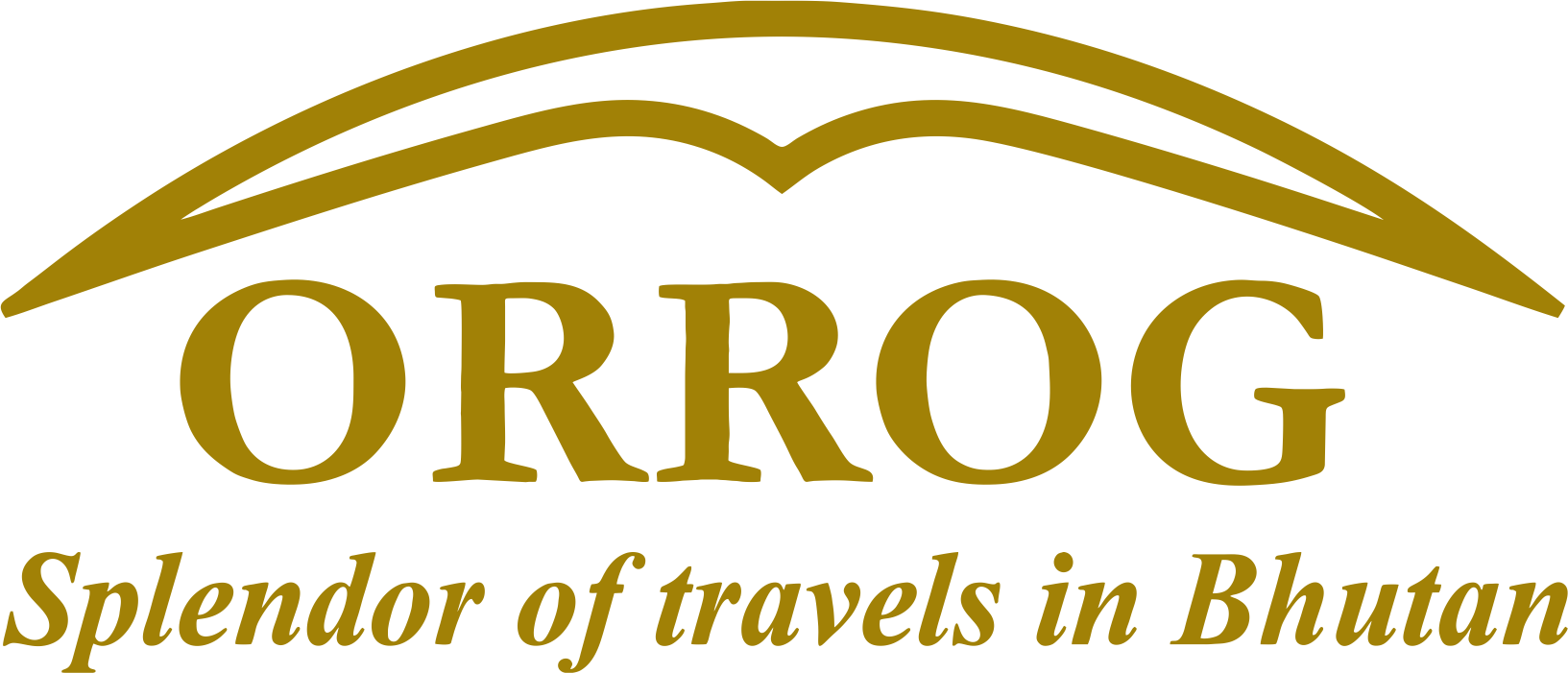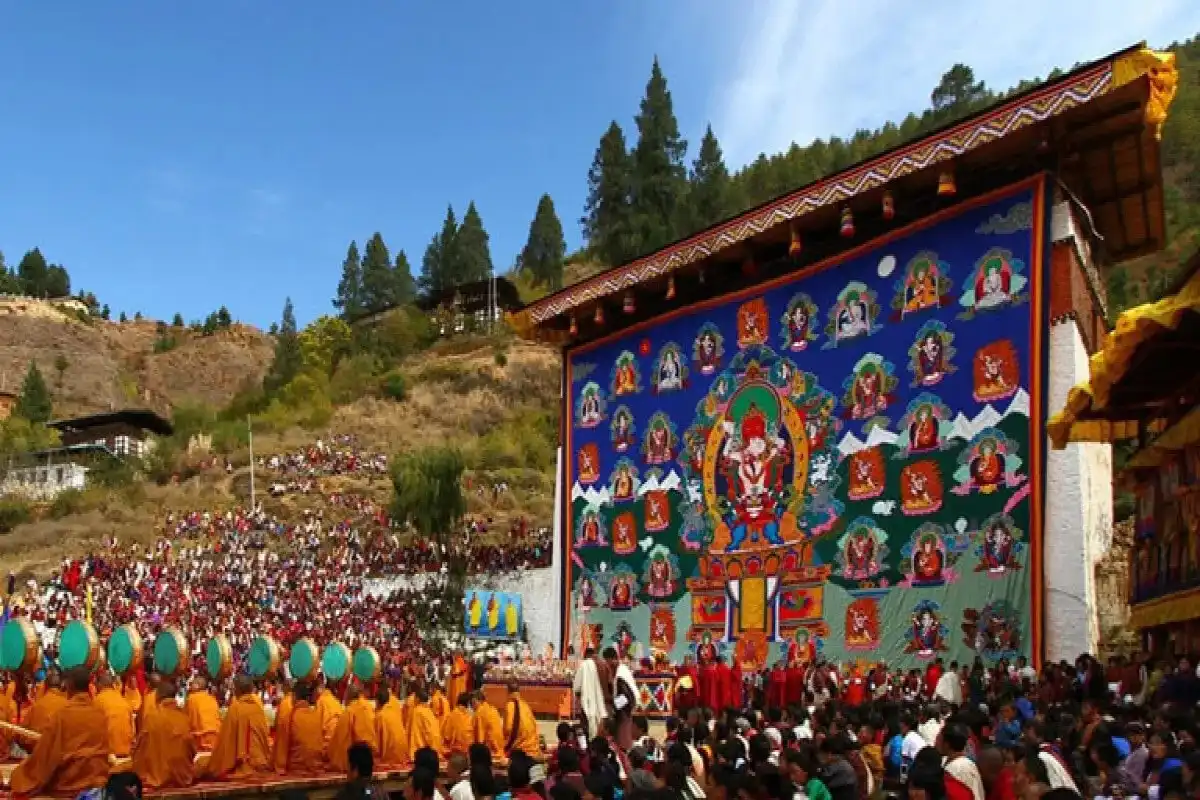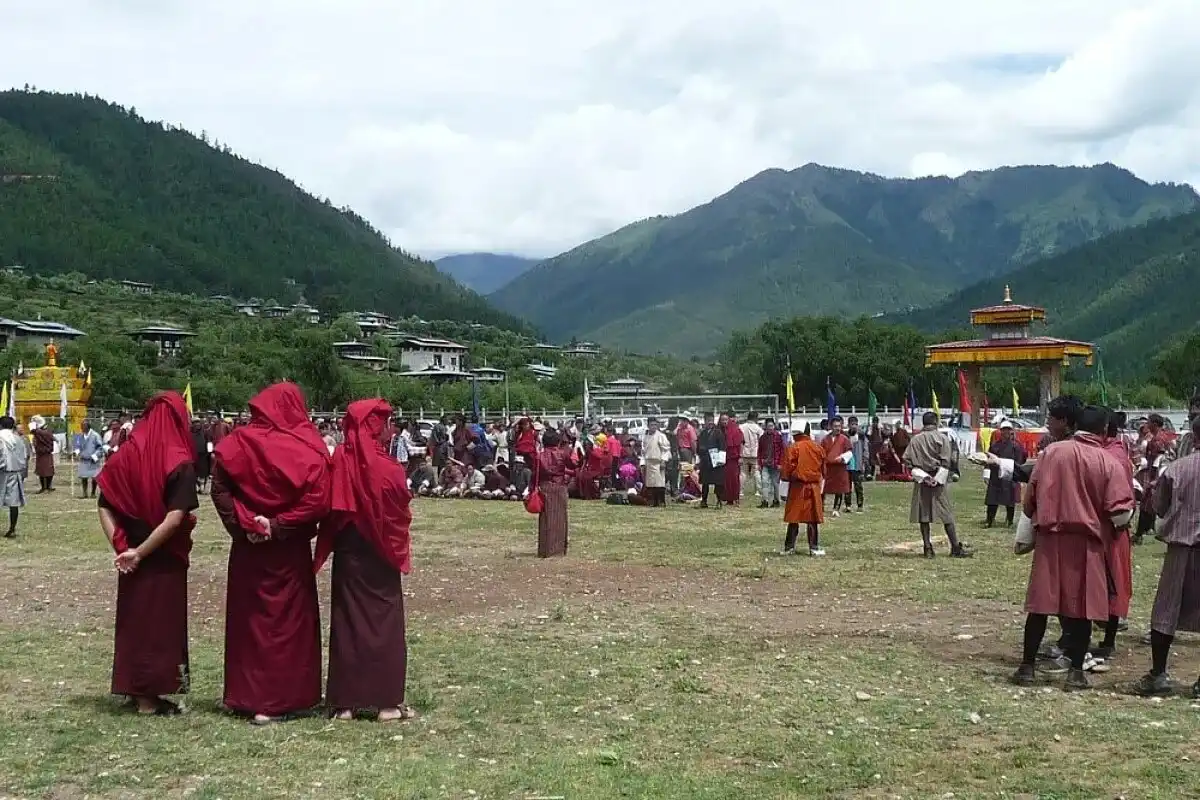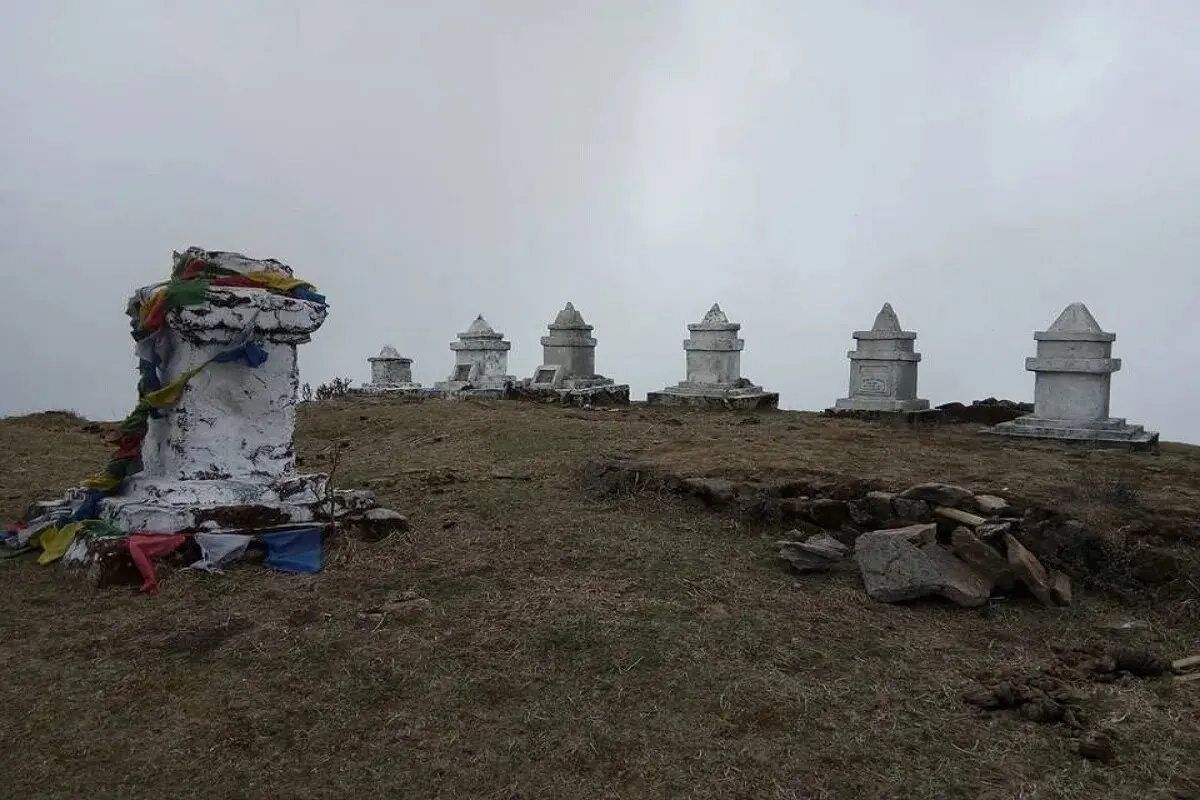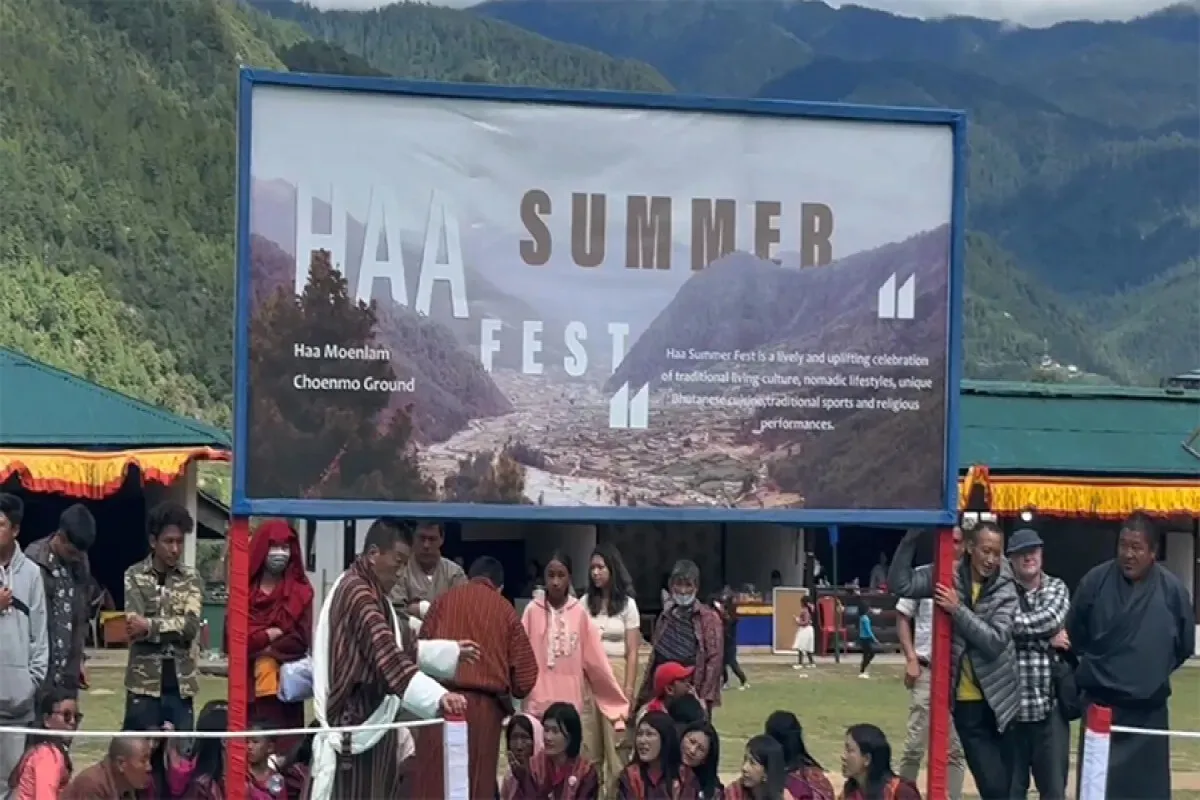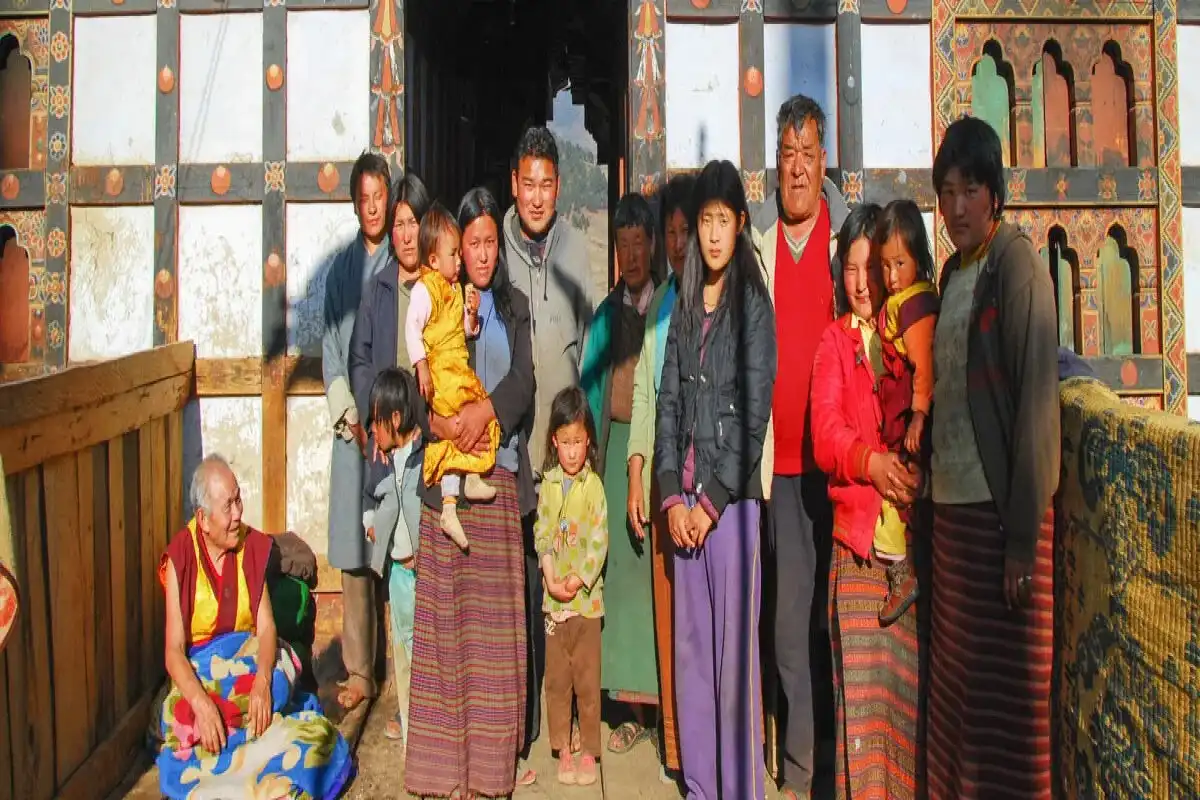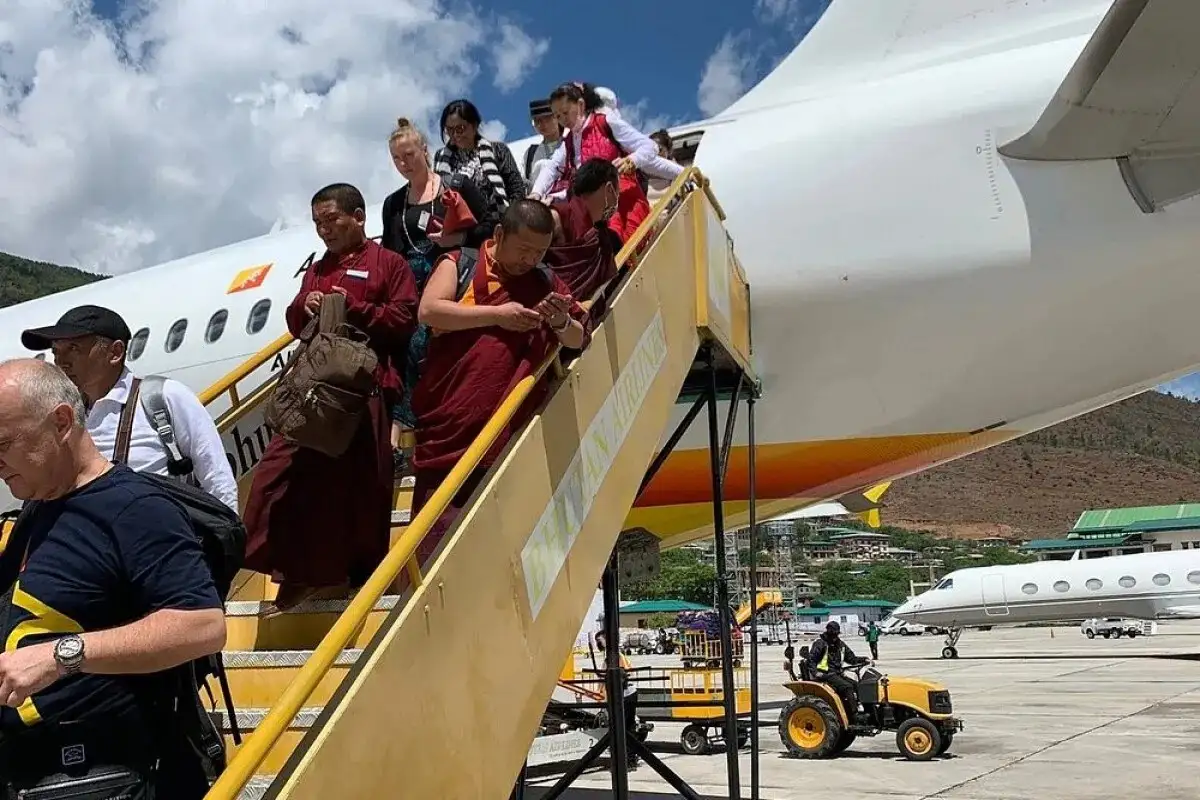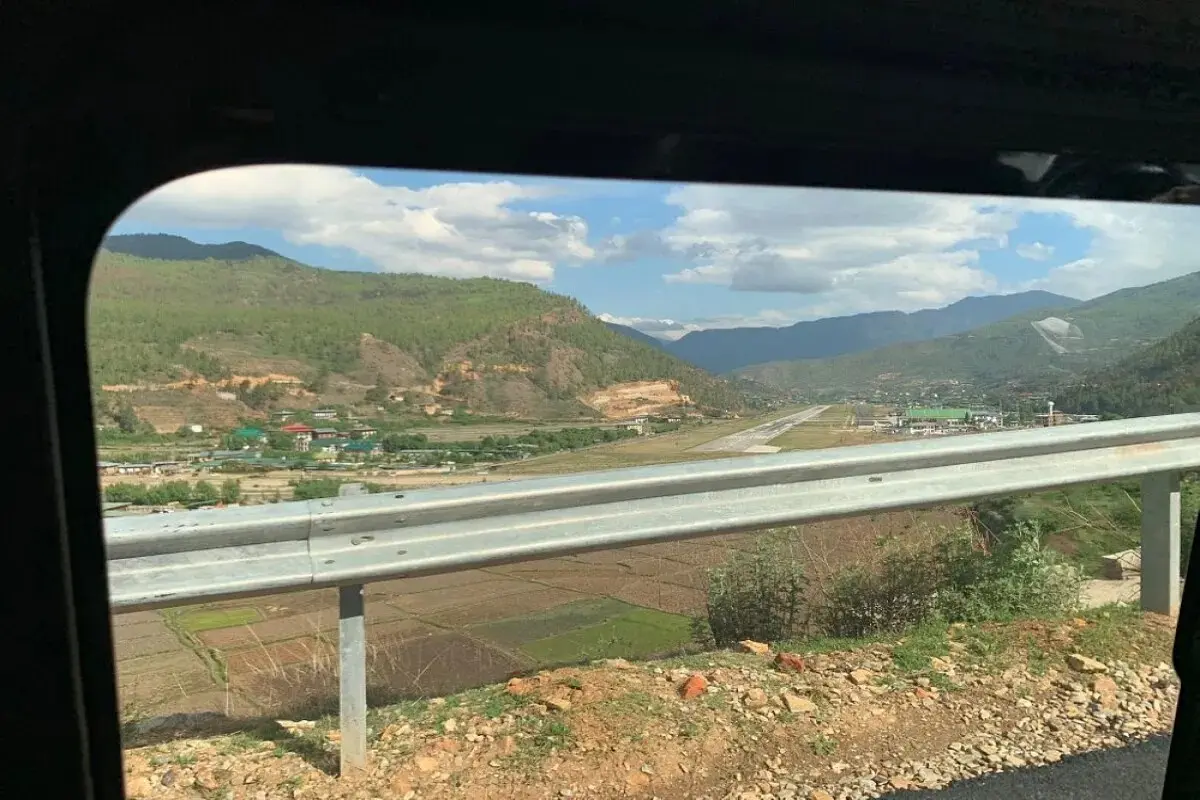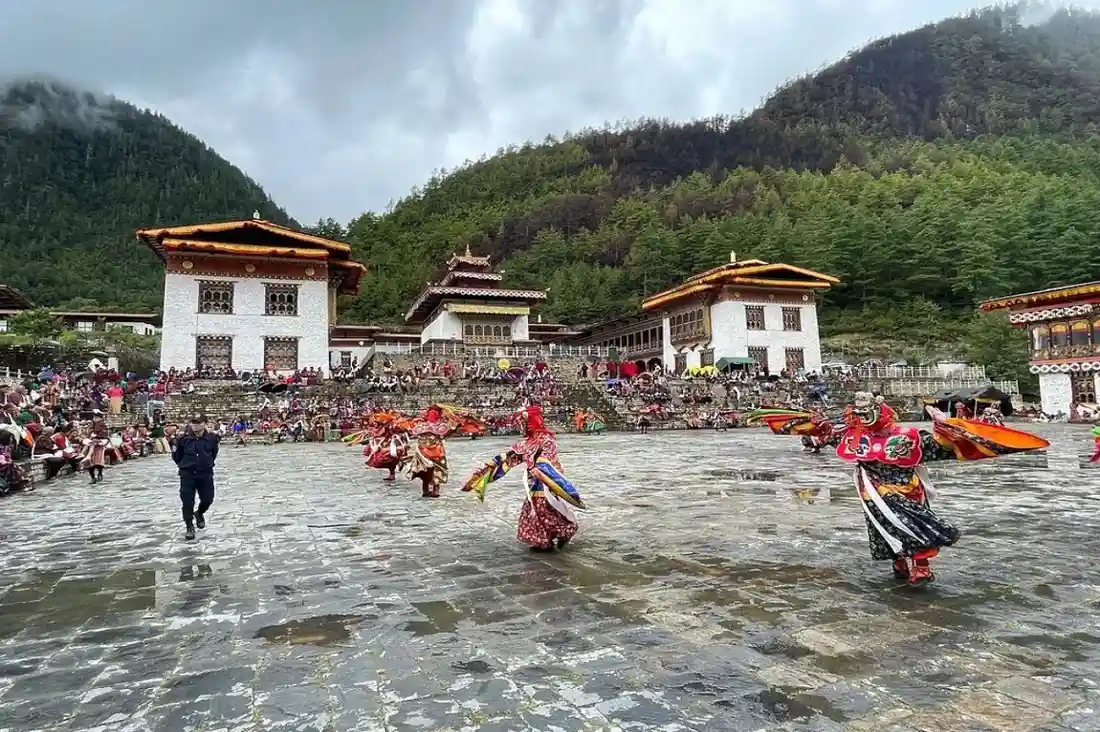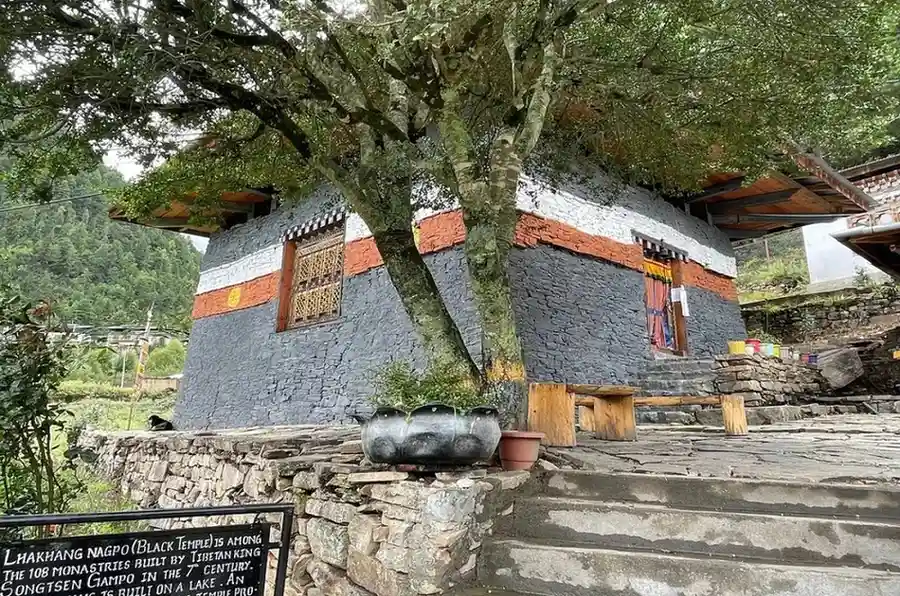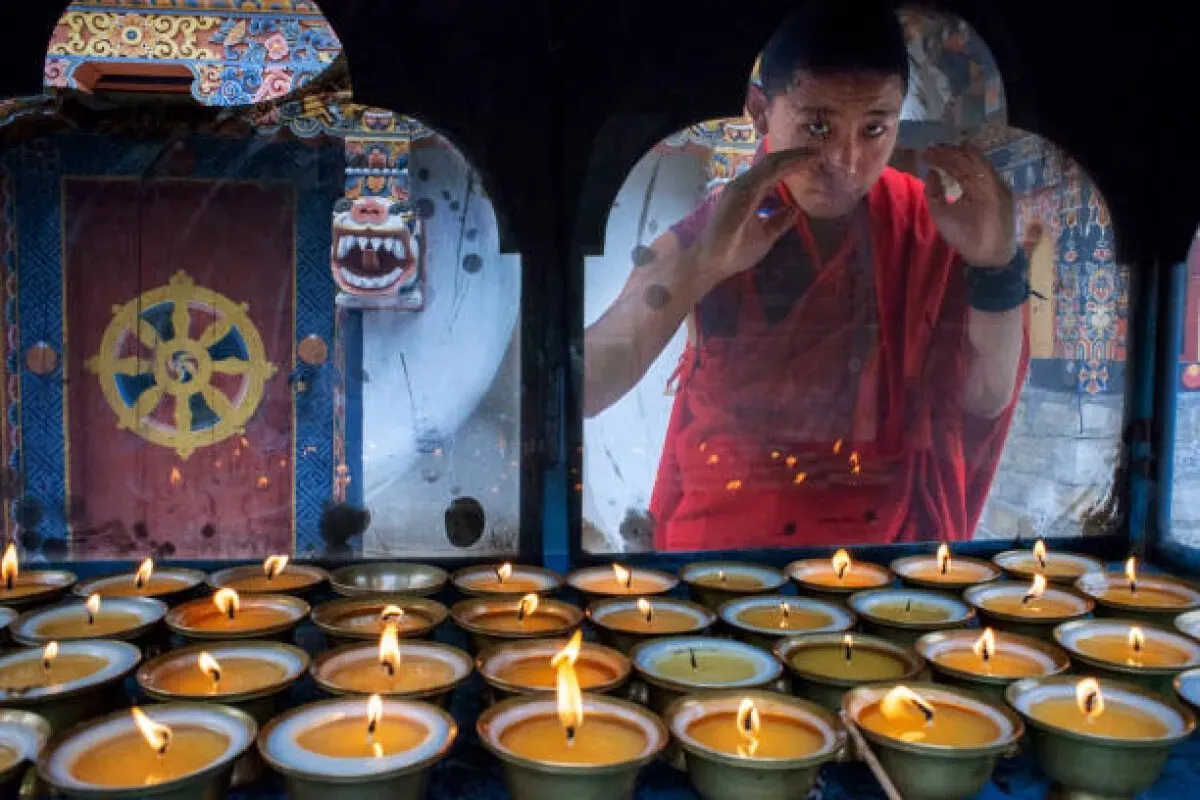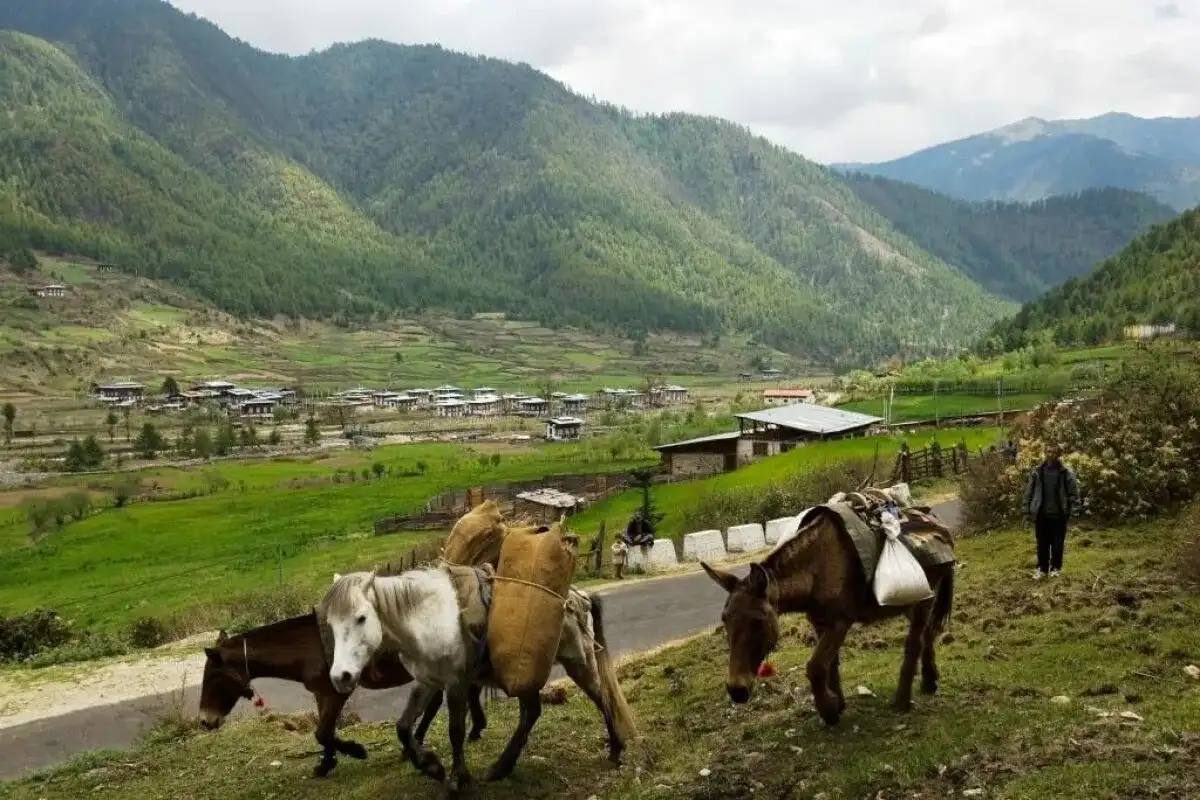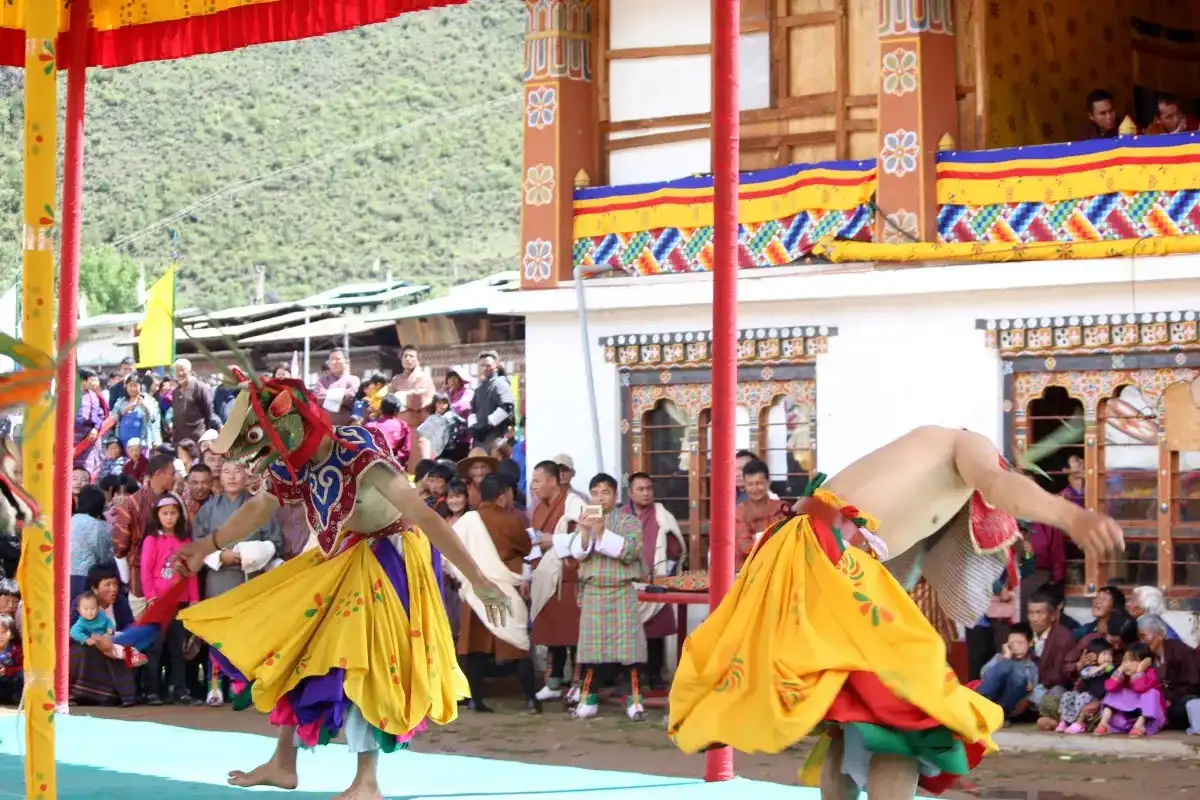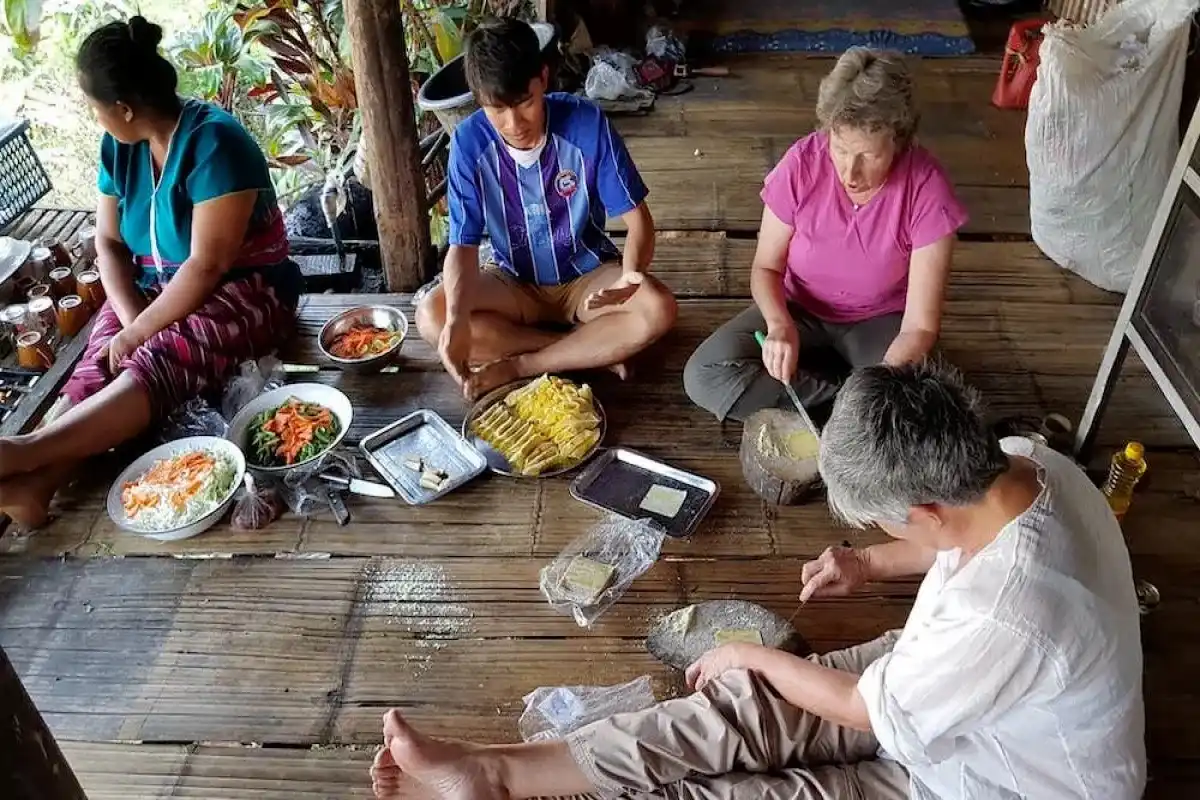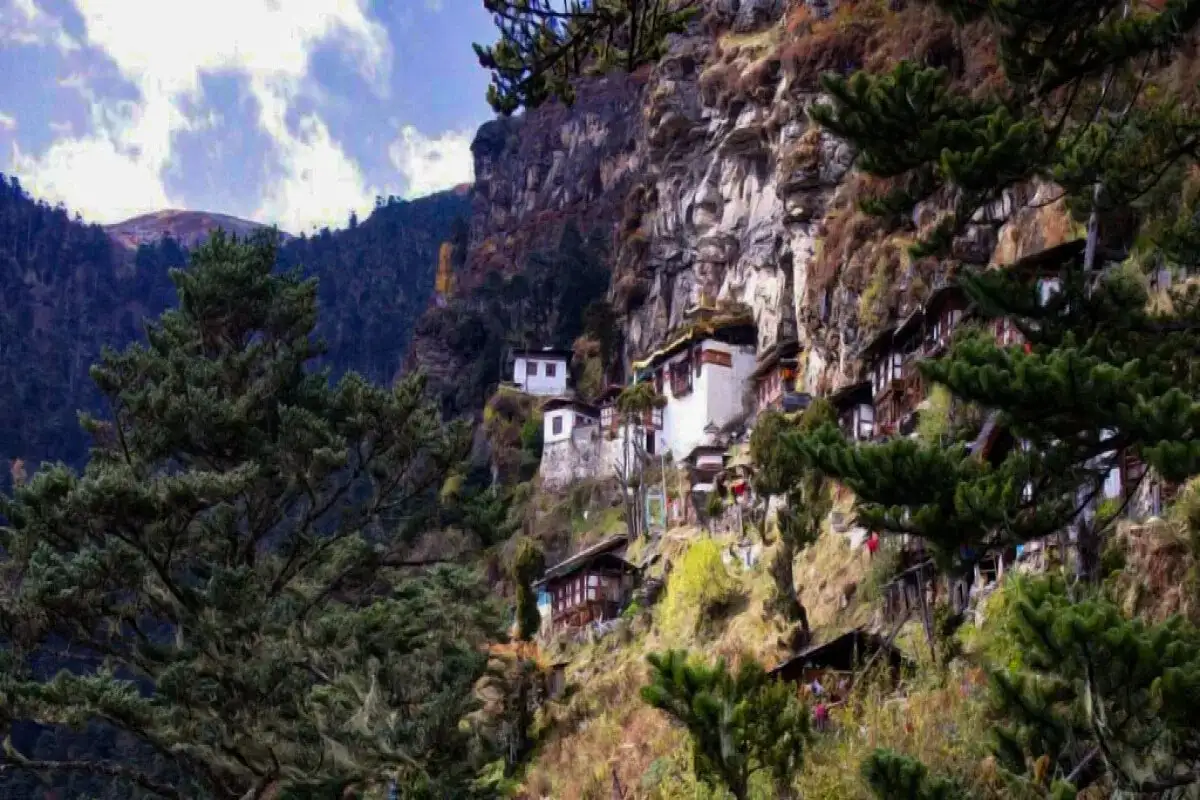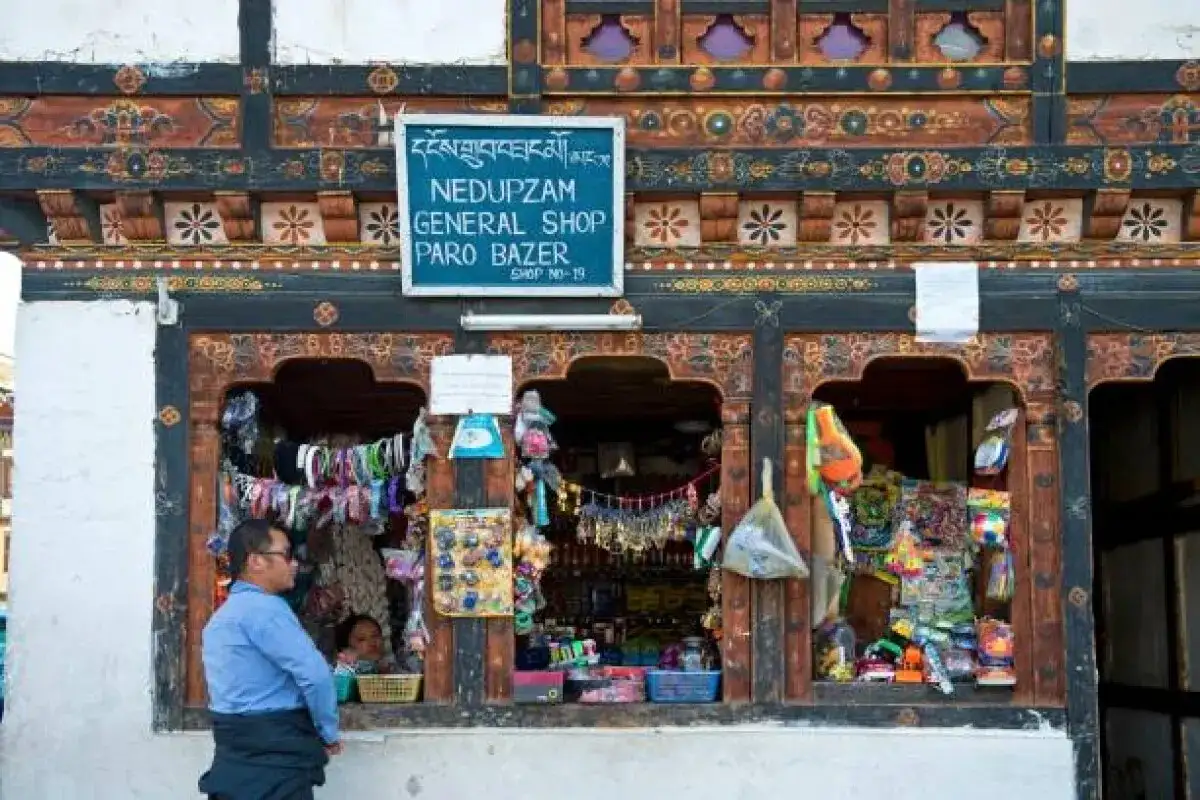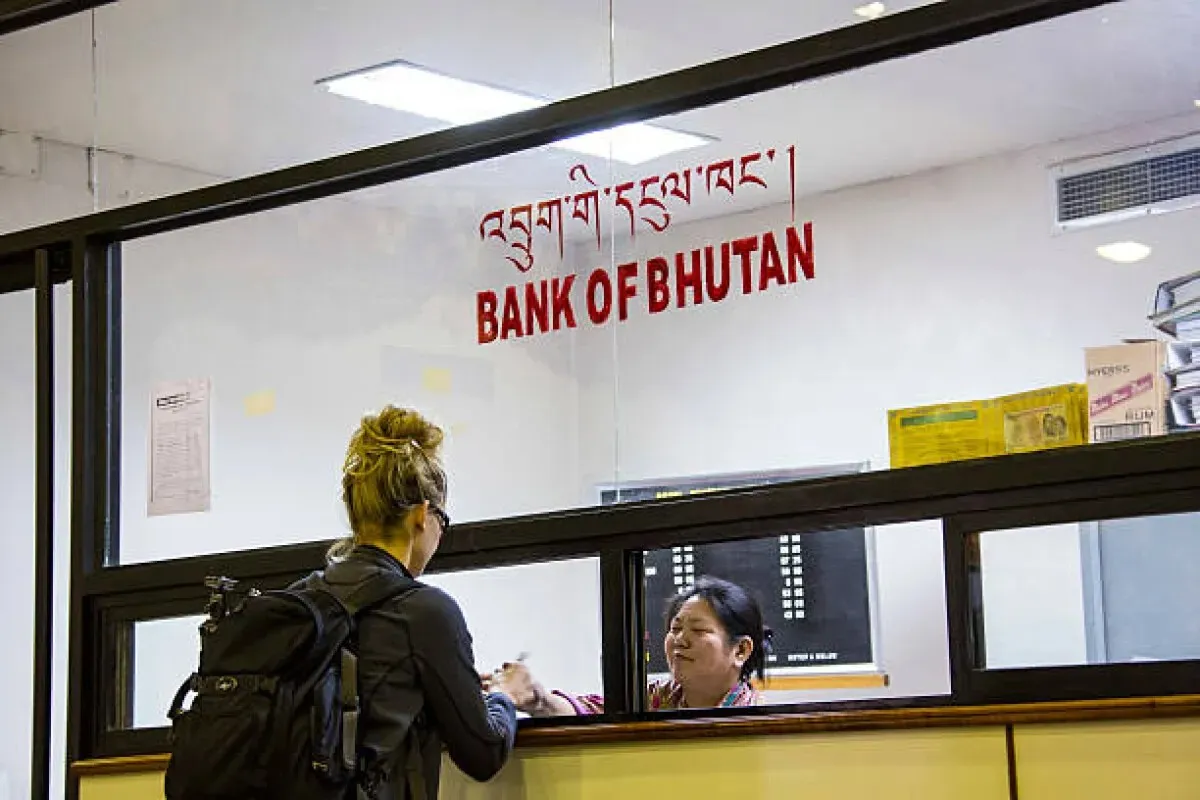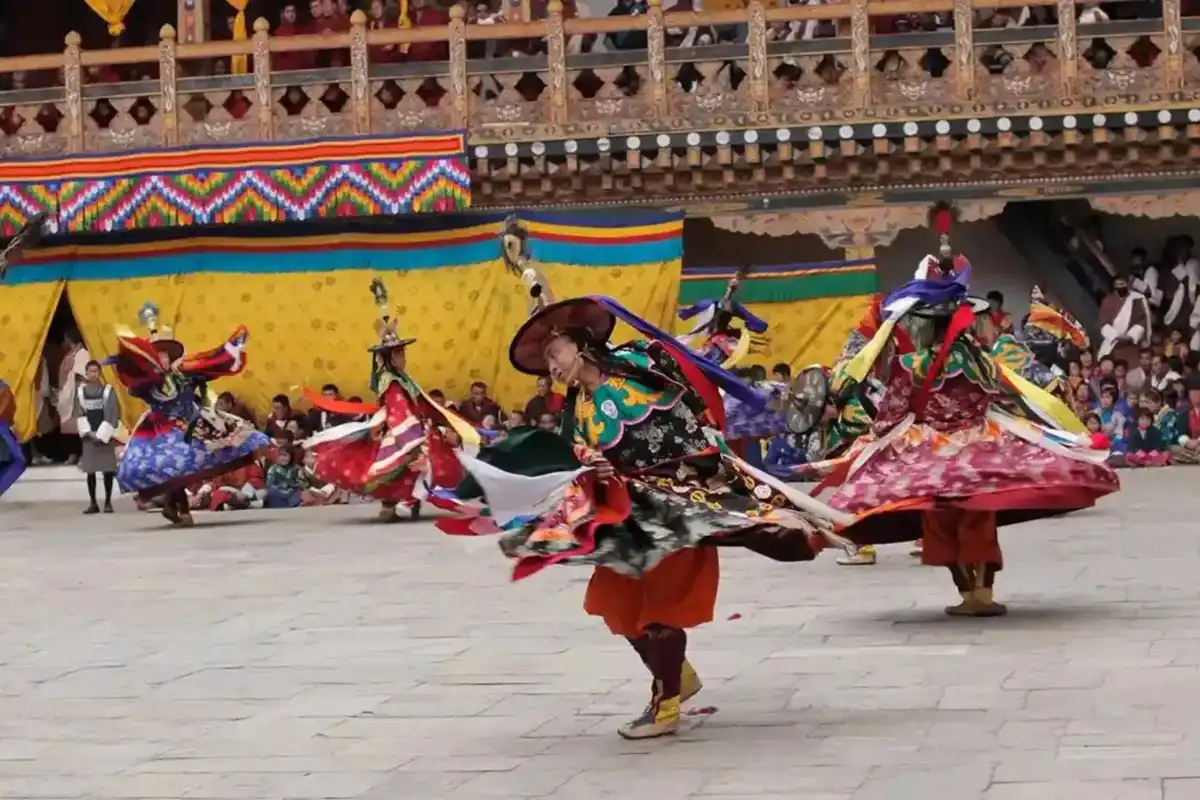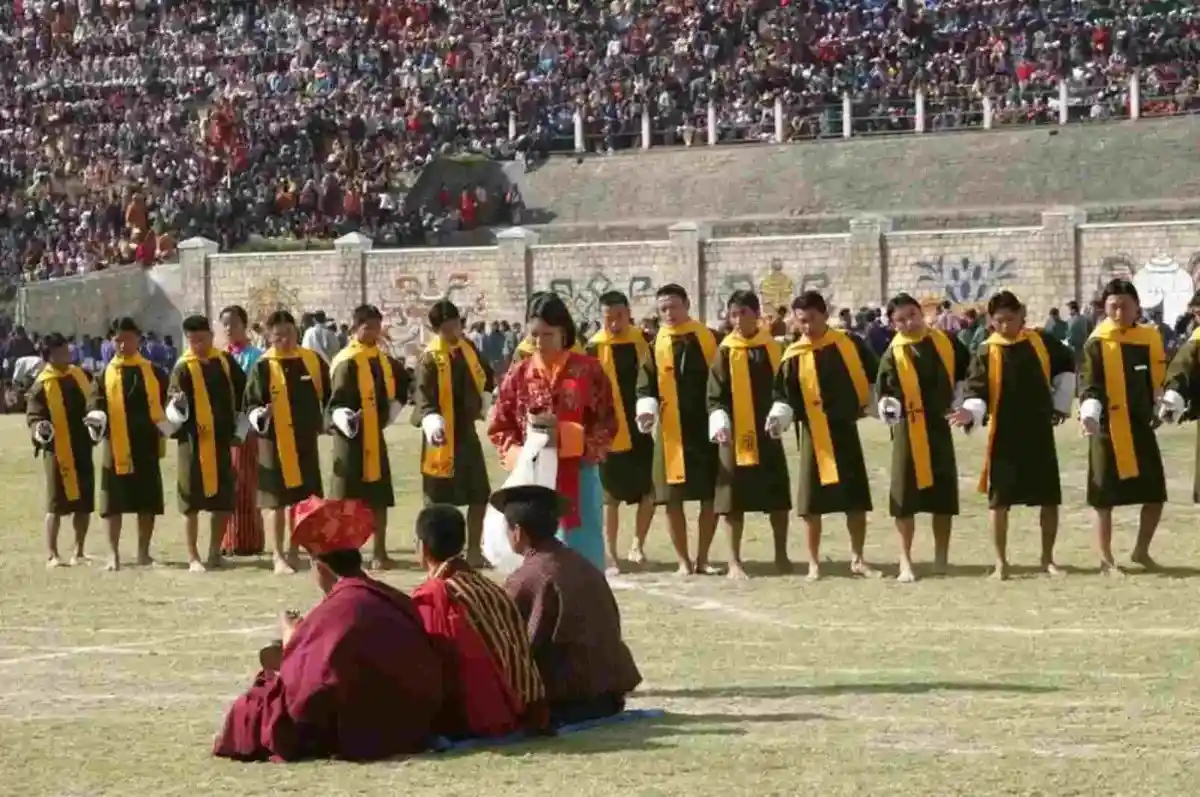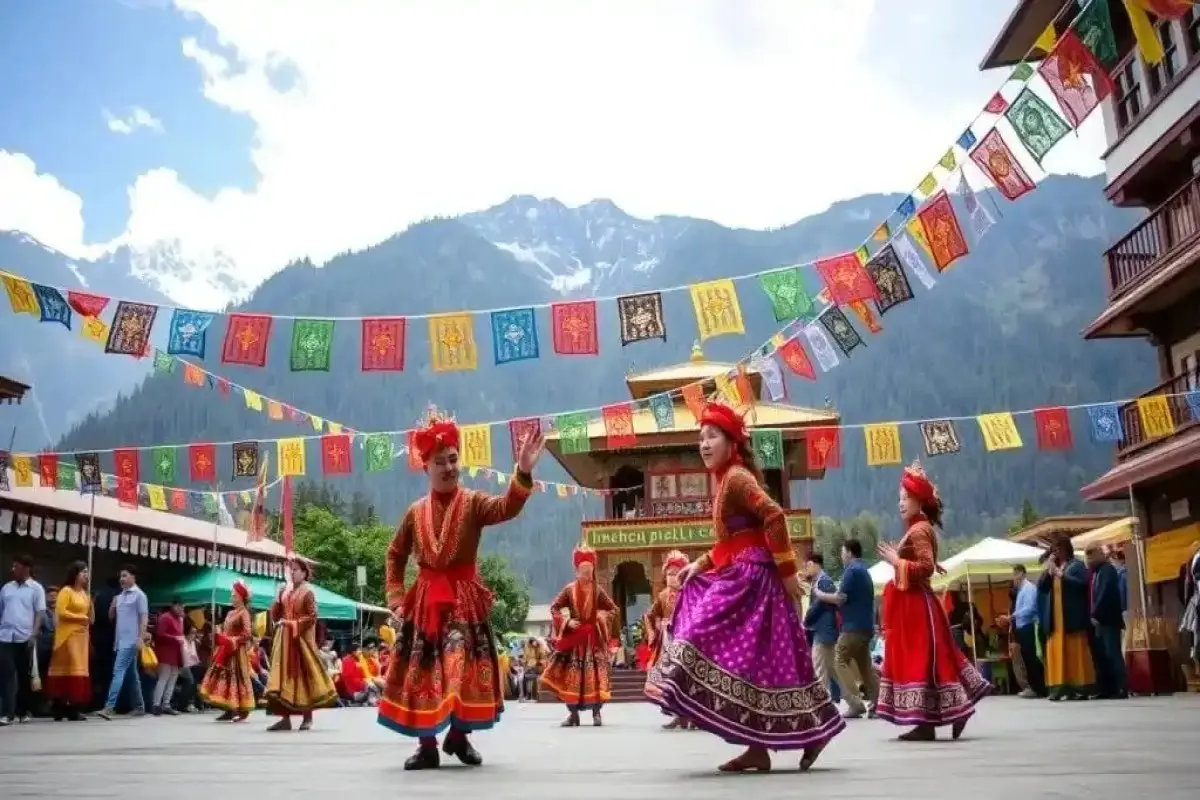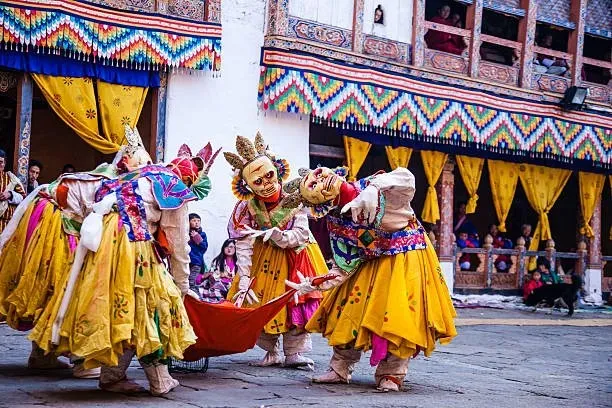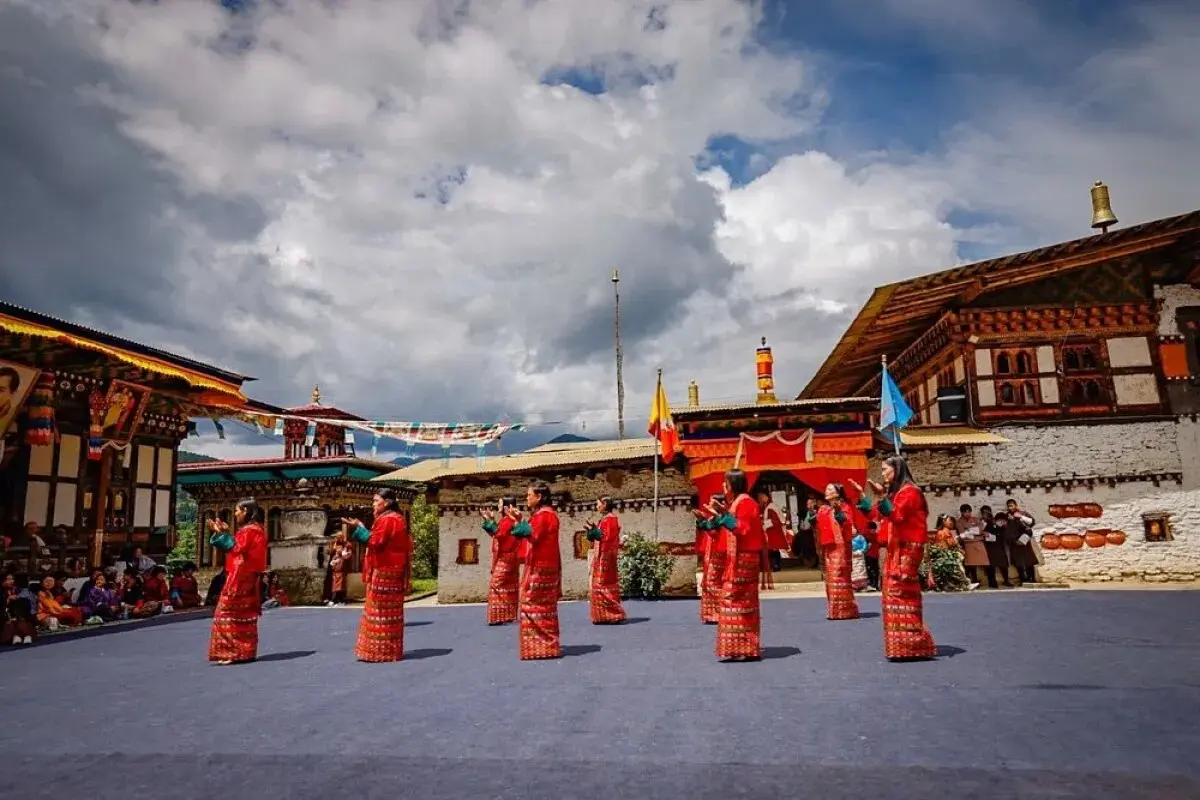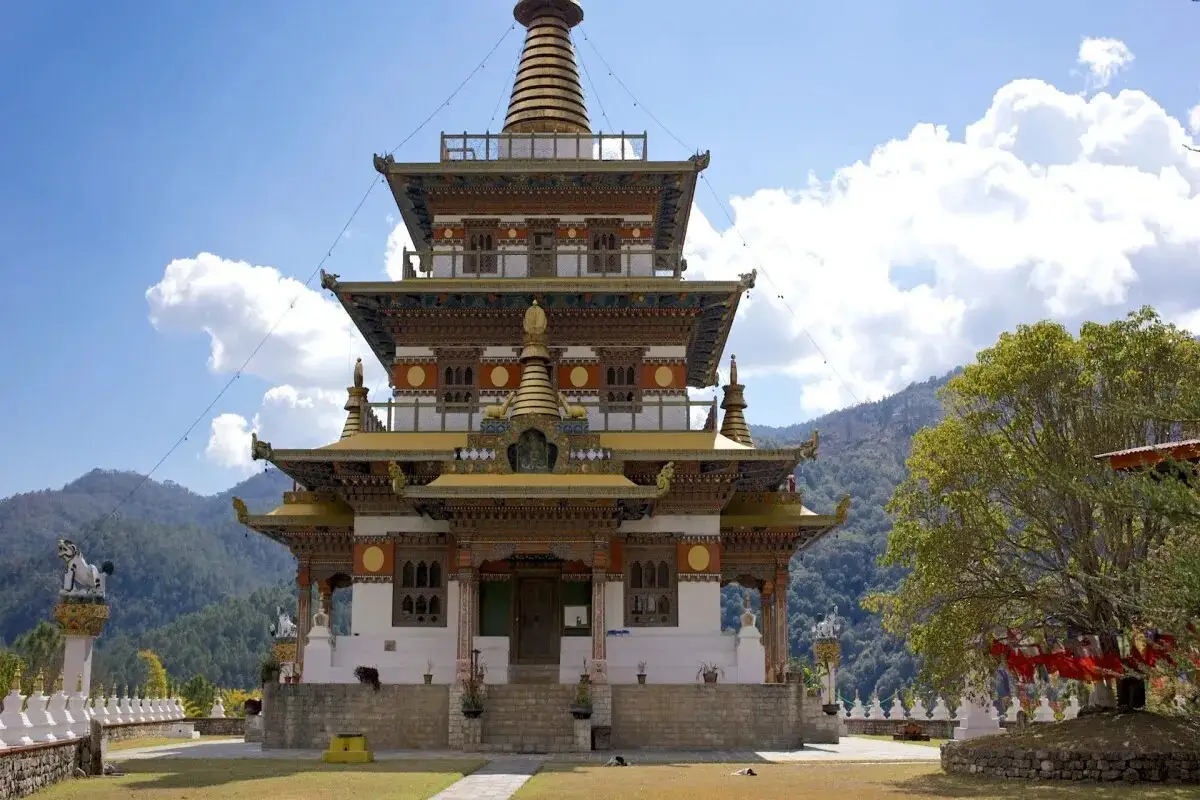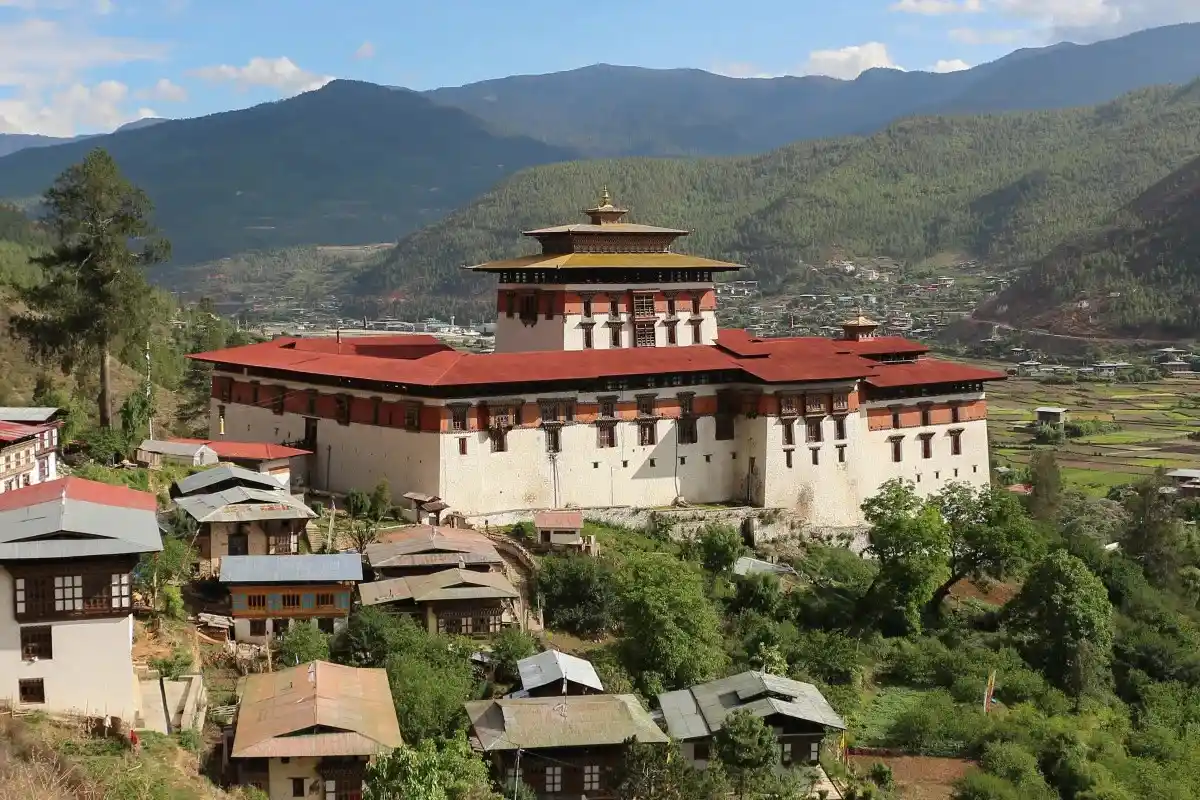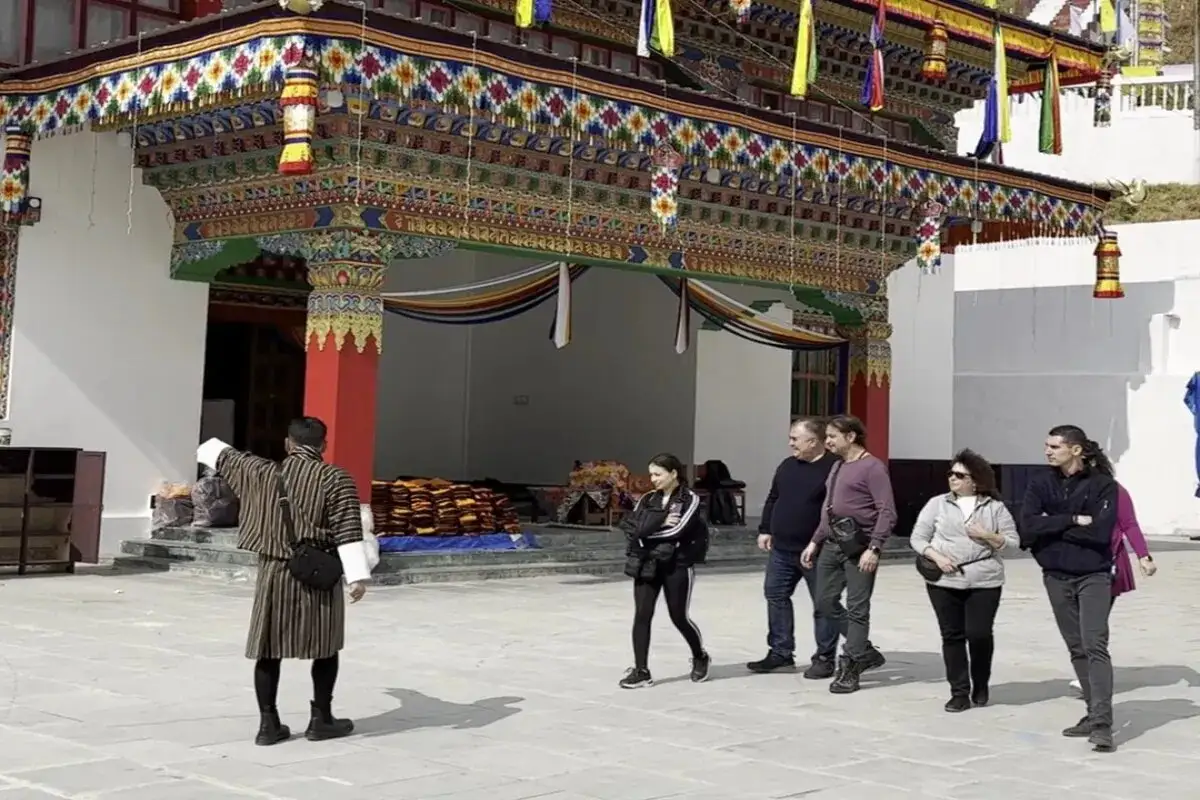Cultural Exploration of Haa Valley - 4 Days
Haa Valley is a tranquil and picturesque valley located in western Bhutan. The valley is renowned for its calmness, mountains, forests, and traditions, and is one of the least-explored areas of Bhutan. The valley is also culturally and historically rich with old temples, forts, and traditional houses. People in Haa still live their simple lives and follow the old traditions.
Highlights
- Visit to Haa Dzong
- Explore Lhakhang Karpo and Lhakhang Nagpo
- Authentic Bhutanese food and dress
- Cultural immersion and interaction with locals
Trip Overview
This 4-day excursion begins in Paro and, as you proceed, offers a spectacular view from Chele La Pass. You will explore holy sites, nearby villages, and trek through forests. In these villages, you can learn weaving and archery. You will also interact with residents and taste their food. The tour is easy, relaxing, and full of culture and nature. This tour is suitable for anyone looking for a peaceful and enriching travelling experience.
We, the Orrog team, have bought an excellent travel plan for your trip. You can also make some changes in the plan according to your destination, time, and budget. You can directly reach out to us to obtain information about the trip.
Quick information
Destination: Haa Valley
Maximum Altitude: 3,988 meters
Difficulty: Easy
Duration: 4 days
Best Season: Spring and Autumn
Accommodations: Included
Meals: Breakfast, Lunch, Dinner
Highlights of Haa Valley Cultural Exploration
Haa Valley cultural exploration is one of the best way to experience the culture of Bhutan.You will get to explore variouse dzongs and monastries .Some highlights of this trip are :
Visit to Haa Dzong, Bhutan
Haa Dzong is a big white building with a perceived hue of red and gold on the top. The road to the fortress is silent, clean, and adorned with trees. Within the fortress, you will observe monks engaged in chanting and meditation, and various paintings and sculptures of Buddha. You must visit the Dzong if you want inner peace and spirituality.
Explore Lhakhang Karpo and Lhakhang Nagpo
Lhakhang Karpo and Lhakhang Nagpo are situated in Haa Valley. The temples are old and peaceful. You will visit the Karpo temple first. The white temple is also another name for this temple. The temple is near a road. You will see beautiful paintings and bright butter lamps here. Then, you will hike to Lhakhang Nagpo. This temple is called the Black Temple. You will stroll through trees and nature. This temple is not lighted and small. You will be able to hear people's prayers. These temples are holy.
Authentic Bhutanese food and dress
You will get an opportunity to have the actual Bhutanese food and dress in traditional attire. It is all simple, delicious, and cultural. First of all, you can consume the local food. Bhutanese consume plenty of rice, cheese, and chili. The favorite dish is called Ema Datshi. They make it with chili and cheese. It is slightly spicy, but very tasty. People cook the meals lovingly and carefully.
Once you have consumed food, you can wear a Bhutanese dress. For a boy, it is a Gho. For a girl, it is a Kira. They are neat and colorful. You will feel strong and calm once you have worn it. You will see a lot of people wearing their dresses every day proudly. It constitutes reverence for their nation and heritage. Bhutanese food and dress are simple but extremely distinct.
Cultural immersion and interaction with locals
You will enjoy yourself in Bhutan with the culture and meeting people, and local interaction. You can walk through the villages. The house is simple and clean. The people are good-natured and friendly. You can visit the local family home. They will invite you first to have a butter tea. It will taste different, but you will like it. You can have a talk with the locals and learn about their culture and traditions. You can also participate in their festival. They would wear masks and clothes that are colored. Their music is loud and powerful. You can also dance with them. After spending time with them, you will be near to knowing them. Their lives are simple but peaceful and loving.
Beauty of the Haa Valley, Bhutan
The Haa Valley is a tranquil and picturesque small town. It is a less-explored valley. The valley is replete with natural beauty and cultural richness. The region has verdant elevated hills and flowing streams. There are forests, fields, and snow mountains in view. The valley is adorned with flowers during spring and summer. The valley is perfect for trekking and walking. You are able to unwind amidst nature. The river that flows through the valley creates a soft, calming noise.
The people of the Haa Valley lead a simple life. They live according to traditional customs and traditions. They are exceptionally kind and accommodating to guests. The valley has various medieval temples and monasteries. During celebrations, the people dance to traditional music while wearing multicolored clothing. They are festive times when relatives and friends come together. Haa Valley is a secret gem. It is tranquil, beautiful, and culturally affluent. A trip to the valley is similar to traveling back in time and entering a simpler world.
Conclusion
Your four-day trip to the serene Haa Valley will be filled with nature, culture, and tranquility. There is something unique and simple to enjoy every day. This tour is straightforward and packed with authentic experiences. Individuals seeking relaxation and a connection with culture and environment would like it. You'll come home with peaceful feelings, new friends, and wonderful memories. Allow Orrog to facilitate the arrangement of your perfect trip. We are prepared to assist you at any opportunity.
This 4-day excursion begins in Paro and, as you proceed, offers a spectacular view from Chele La Pass. You will explore holy sites, nearby villages, and trek through forests. In these villages, you can learn weaving and archery. You will also interact with residents and taste their food. The tour is easy, relaxing, and full of culture and nature. This tour is suitable for anyone looking for a peaceful and enriching travelling experience.
We, the Orrog team, have bought an excellent travel plan for your trip. You can also make some changes in the plan according to your destination, time, and budget. You can directly reach out to us to obtain information about the trip.
Quick information
Destination: Haa Valley
Maximum Altitude: 3,988 meters
Difficulty: Easy
Duration: 4 days
Best Season: Spring and Autumn
Accommodations: Included
Meals: Breakfast, Lunch, Dinner
Highlights of Haa Valley Cultural Exploration
Haa Valley cultural exploration is one of the best way to experience the culture of Bhutan.You will get to explore variouse dzongs and monastries .Some highlights of this trip are :
Visit to Haa Dzong, Bhutan
Haa Dzong is a big white building with a perceived hue of red and gold on the top. The road to the fortress is silent, clean, and adorned with trees. Within the fortress, you will observe monks engaged in chanting and meditation, and various paintings and sculptures of Buddha. You must visit the Dzong if you want inner peace and spirituality.
Explore Lhakhang Karpo and Lhakhang Nagpo
Lhakhang Karpo and Lhakhang Nagpo are situated in Haa Valley. The temples are old and peaceful. You will visit the Karpo temple first. The white temple is also another name for this temple. The temple is near a road. You will see beautiful paintings and bright butter lamps here. Then, you will hike to Lhakhang Nagpo. This temple is called the Black Temple. You will stroll through trees and nature. This temple is not lighted and small. You will be able to hear people's prayers. These temples are holy.
Authentic Bhutanese food and dress
You will get an opportunity to have the actual Bhutanese food and dress in traditional attire. It is all simple, delicious, and cultural. First of all, you can consume the local food. Bhutanese consume plenty of rice, cheese, and chili. The favorite dish is called Ema Datshi. They make it with chili and cheese. It is slightly spicy, but very tasty. People cook the meals lovingly and carefully.
Once you have consumed food, you can wear a Bhutanese dress. For a boy, it is a Gho. For a girl, it is a Kira. They are neat and colorful. You will feel strong and calm once you have worn it. You will see a lot of people wearing their dresses every day proudly. It constitutes reverence for their nation and heritage. Bhutanese food and dress are simple but extremely distinct.
Cultural immersion and interaction with locals
You will enjoy yourself in Bhutan with the culture and meeting people, and local interaction. You can walk through the villages. The house is simple and clean. The people are good-natured and friendly. You can visit the local family home. They will invite you first to have a butter tea. It will taste different, but you will like it. You can have a talk with the locals and learn about their culture and traditions. You can also participate in their festival. They would wear masks and clothes that are colored. Their music is loud and powerful. You can also dance with them. After spending time with them, you will be near to knowing them. Their lives are simple but peaceful and loving.
Beauty of the Haa Valley, Bhutan
The Haa Valley is a tranquil and picturesque small town. It is a less-explored valley. The valley is replete with natural beauty and cultural richness. The region has verdant elevated hills and flowing streams. There are forests, fields, and snow mountains in view. The valley is adorned with flowers during spring and summer. The valley is perfect for trekking and walking. You are able to unwind amidst nature. The river that flows through the valley creates a soft, calming noise.
The people of the Haa Valley lead a simple life. They live according to traditional customs and traditions. They are exceptionally kind and accommodating to guests. The valley has various medieval temples and monasteries. During celebrations, the people dance to traditional music while wearing multicolored clothing. They are festive times when relatives and friends come together. Haa Valley is a secret gem. It is tranquil, beautiful, and culturally affluent. A trip to the valley is similar to traveling back in time and entering a simpler world.
Conclusion
Your four-day trip to the serene Haa Valley will be filled with nature, culture, and tranquility. There is something unique and simple to enjoy every day. This tour is straightforward and packed with authentic experiences. Individuals seeking relaxation and a connection with culture and environment would like it. You'll come home with peaceful feelings, new friends, and wonderful memories. Allow Orrog to facilitate the arrangement of your perfect trip. We are prepared to assist you at any opportunity.
Short Itinerary
Arrival in Paro ,Drive to Haa Valley,Visit Haa Dzong and Explore the area
Explore Lhakhang Karpo & Nagpo,Visit Tagechu Goemba for panoramic valley views
Visit Katsho Village,Local lunch with villagers and Evening visit to local market
Return to Paro and Departure
Cultural Exploration of Haa Valley Itinerary
On this day, you will arrive in Paro from your current location. Upon your arrival in Paro, our representative will greet you and they will take you to our office. Upon arriving at the office, you may refresh, sip coffee, and talk with a guide on the tour and itinerary. Then, you will eat lunch in a local restaurant and drive to the Haa Valley.
Upon going for a while, you will arrive at Chele La Pass. You will pause here to appreciate the vista and capture some photos with a colorful, fluttering flag. You can see different peaks from here. A cup of tea and a lovely view are also available. Next, you will move to the valley. Following a brief journey, you will arrive in the valley.Upon arriving in the valley, you will register at the hotel and leave your luggage. You can have a rest for some time. Afterwards, you will explore the Haa dzong. Here, you will see the beautiful fort. You can learn about the history and its architecture. Then, you will return to the accommodation. Next, have dinner and a peaceful sleep.
After waking up, you will be fresh. Then, you will eat breakfast. After completing breakfast, inform the guide. A guide will come and pick you up. Subsequently, you will proceed to the Lhakhang Karpo and Nagpo. These temples are twins. One is known as a black temple and the other as a white temple. Following a brief journey, you will arrive in Lhakhang Karpo. After reaching here, you can worship the god and enjoy nature.
Then, you will hike to Nagpo Temple. You have to hike for 15 minutes. You will hike through the forest. You can see different types of birds. A bird's sound will make your tour more enjoyable. After reaching the temple, you will explore it. Then, you will sit near the teashop and enjoy the tea with a beautiful view. Subsequently, you will return to the valley.Then, you will have a lunch. Upon completing lunch, you may take some time to unwind. Then, you will explore Tagechu Gomba. You can get a broad perspective of the valley from here. Buddhism can also be learned here. You will thereafter return to the hotel.
Upon awakening today, you will be fresh and engage in breakfast. Then, you will move towards the Yangthang village. The route features agricultural terrain and diverse vistas. You will settle for a short journey. Here, you will see lots of Yak. You can also see the yak hair rope. You can furthermore acquire the skills to create it. Here, you can also learn archery from locals.
After that, you will move towards the Katsho village. Here, you will see an old traditional house. You can also learn sisal-silk weaving in this village. Then, you will eat lunch with locals. You can also capture photos with locals. You can learn their culture and traditions. After that, you will return to the hotel. Subsequently, you may rest for hours.You will visit the local market in the evening. You can buy local goods. You can also interact with locals. After that, you will return to the accommodations. If you visit this village in July, you can join in the Haa summer festival.
After waking up, you will take part in sunrise archery. Then, you will pack your bags. Subsequently, you will partake in breakfast and coffee while enjoying a picturesque vista. You will thereafter board an SUV and proceed to Paro. You will follow the same path you have come. After traveling for some hours, you will reach Kila Nunnery. Here, you will pause and drink tea. You can also capture photos in this village.
Next, you will move to Paro. After reaching Paro, you will have lunch. Then, you can relax for some hours. Afterward, we will drop you off at the Paro airport. You will be transported to the airport 3 hours earlier for the flight. If you reside in a close location, we will provide a private vehicle. While traveling home, you will take lots of memories with you.
Know Before You Travel
-
Haa Valley things to do:
There are many enjoyable activities to engage in while at the Haa Valley. In order to have more knowledge about the history and culture of the valley, you can visit religious sites. Trekking and walking through the green forests and hills is a good way to enjoy the scenic views. You can also try foods like red rice, ema datshi, and hot butter tea. One other such enjoyable experience is visiting tiny villages, where you get to know how people reside and understand their daily lives. You can also get to see vibrant dances and music if you visit them during the local festival. You can also have a peaceful picnic by the river and try shooting using a bow and arrow. Your valley tour will be peaceful, beautiful, and culturally rich.
Cultural Exploration of Haa Valley Map
Download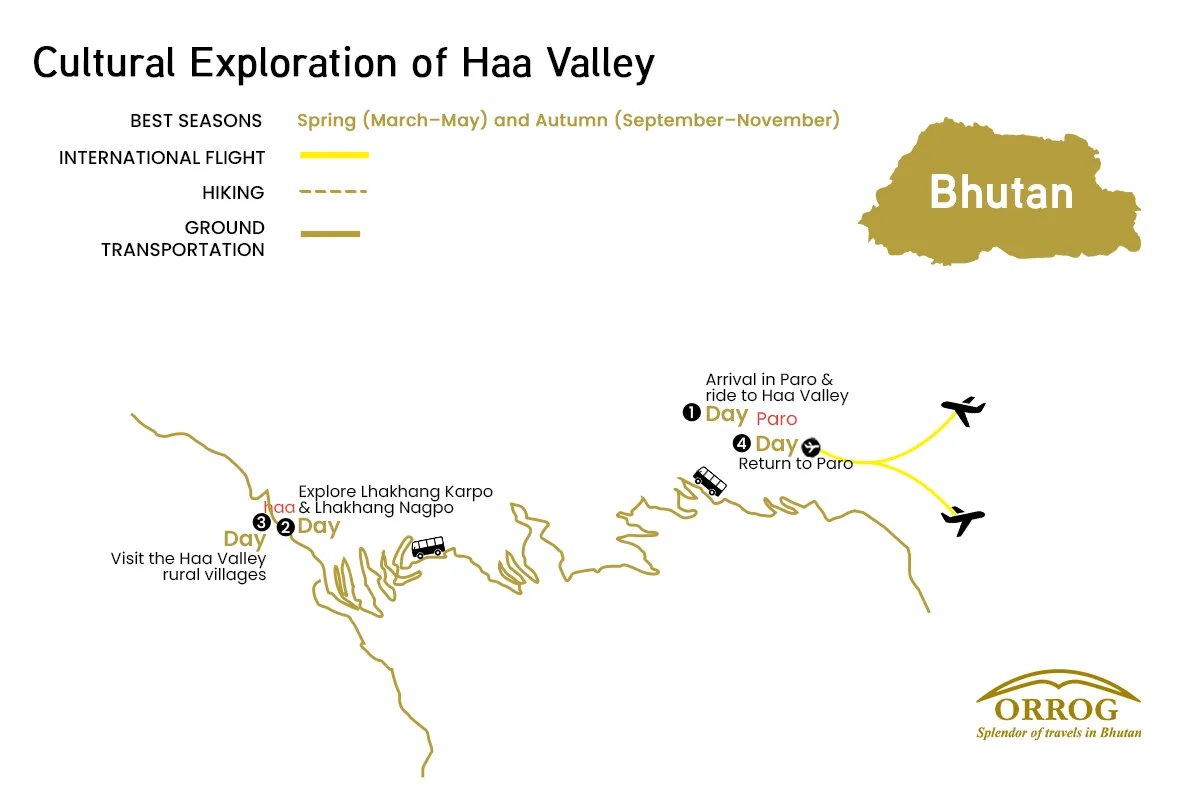
FAQs for Cultural Exploration of Haa Valley
Orrog is one of the certified tour and travel companies with years of experience. We offer trips to explore Bhutan’s stunning scenery, vibrant culture, and warm hospitality. We also provide English-speaking certified guides.
Visitors know Haa Valley for its sightseeing and peaceful sites. Lhakhang Karpo (White Temple), Lhakhang Nagpo (Black Temple), Haa Dzong, and Chele La Pass are some top places that you must visit in the Haa Valley.
The distance from Paro to Haa Valley is approximately 65 kilometers. The journey usually lasts 2.5 hours by car, based on road conditions and stops along the way. The route traverses the Chele La Pass.
Haa Valley is approximately 2,670 meters above sea level. The elevation makes the air crisp. Also, temperatures can change a lot from day to night.
Yes, Haa Valley treks are ideal for adventure seekers looking for off-the-beaten-path trails. Routes through Chele La Pass and nearby ridges offer great views. You can see local plants and animals and meet nomadic yak herders.
Chele La Pass is the highest motor road in Bhutan at 3,988 meters. It links Paro to Haa Valley. Enjoy breathtaking views of Mount Jomolhari, vibrant prayer flags, and dense pine forests.
Haa Valley weather is generally cool and temperate. Summers (May to August) are mild and green, while winters (November to February) are cold and often snowy. So, March to June and September to November are ideal periods for the trip.
Since the weather can be unpredictable and temperatures can vary drastically, layered clothing is essential. You should pack:
- Base layers (thermal tops and bottoms)
- Insulating layers like fleece or down jackets
- Waterproof and windproof outer layers
- Warm hats, gloves, and neck gaiters for freezing conditions
- Moisture-wicking socks and weatherproof trekking boots
Nighttime temperatures can be extremely cold, especially at high-altitude places. So you need to have enough clothing to keep you warm.
The weather is clear with mild daytime temperatures during spring and autumn.
You need a visa and all necessary permits for your trip. These documents can not be received on the day of your arrival, so they must be processed before coming here. After you book a trip with us, we will manage these papers for you. Your Bhutan visa is arranged by Orrog as part of the package.
The main way to come to Bhutan is through Paro International Airport, which is well-connected to cities like Bangkok, Delhi, Kathmandu, and Singapore. Most people arrive by air, but if you plan to come via road, you can enter through Phuentsholing, located on the southern border with India, which is the most commonly used entry point.
It is recommended to apply for the visa at least 20 days before your planned departure date so that there is enough time for processing your Bhutan visa, finalizing your itinerary, and arranging your guides and transportation. Although visa processing itself is relatively fast once payment is received, early preparation helps avoid delays and ensures availability, especially during peak seasons (spring and autumn).
You don’t require a passport-size photo for the visa, but it is wise to carry at least 2–4 recent passport-sized photographs during your trip. These may be needed for local permits, registration, or when applying for a local SIM card upon arrival in Bhutan.
Yes, you can lengthen your stay in Bhutan either before or after your trip. Bhutan’s tourism model requires visitors to pay a Sustainable Development Fee (SDF) and a daily package cost, so any extra days will involve additional charges. Extensions are a great opportunity to explore cultural sites in Paro, Thimphu, or even add another short trip or day hike.
Yes, Bhutan requires full tour payment in advance before your visa can be processed and issued. The government of Bhutan regulates this policy to ensure that all travel arrangements are confirmed through a licensed Bhutanese tour operator. We are a licensed tour operator that ensures you have everything you need for a trouble-free trip.
Any personal expenses are not covered in the package like:
- Tips for your guide and other staff
- Bottled drinks and snacks(personal expense)
- Souvenirs or local crafts
Credit cards are easily accepted in major cities like Paro and Thimphu. But in remote areas, you may not have access to a card or an ATM. So, it is best to carry some cash before heading for the trip.
Tipping is not mandatory, but it is a widely appreciated gesture and a customary way to show gratitude for good service. The tipping guideline would be to give USD 5-10 per day as a tip for the guides and other staff.
Paro International Airport is the only international airport in Bhutan. It is well connected by flights from cities like Bangkok, Delhi, Kathmandu, and Singapore.
Yes, airport pick-up and drop-off are included in the package. We will have your guide and driver meet you at the airport and transport you to your hotel.
While Bhutan's roads are mostly paved, some parts are narrow, winding, and occasionally affected by weather. However, we ensure your travel is safe, well-maintained, and driven by an experienced professional throughout the journey.
Once you arrive in Paro, we will arrange private ground transportation to the starting point as we pass through lush valleys and traditional villages. So, you don’t have to worry about any transportation services.
Yes, it is very safe to travel even with children in Bhutan. Roads are well-maintained, and the pace of travel is generally relaxed and child-friendly.
We will usually travel in comfortable, private vehicles with experienced drivers. All ground transportation is included in your package.
The Bhutanese Ngultrum is used in Bhutan. All local transactions during the trip will be in BTN.
US Dollars (USD) are generally accepted at larger hotels, souvenir shops, and tour operators, particularly in Paro and Thimphu. However, it’s advisable to convert your currency to BTN for general purchases in rural areas. Other currencies like the Euro or the Pound are not commonly accepted directly.
No, credit or debit cards are not accepted on the trip, as it takes you through remote regions with no banking or electronic payment access. All trip-related payments like accommodation, meals, permits, etc, are paid in advance.
You can exchange foreign currency at the Paro International Airport, at banks, or through licensed money changers in cities like Thimphu and Paro. It's best to exchange enough cash before heading out on the trip.
The national language is Dzongkha, but many Bhutanese also speak English. If you speak English and are worried about communicating with the local people, you will have your guide as a translator.
Yes, all licensed tour guides in Bhutan are required to speak fluent English. Many are also trained in other languages such as German, Japanese, or French. Communication during the trip will be smooth and clear in English.
Most signboards, tourist maps, and information brochures are written in English, especially in tourist destinations like Paro, Thimphu, and trailheads. Directional signs along routes are often labeled in both Dzongkha and English.
No, learning Dzongkha is not at all needed for the trip, but knowing a few basic words like "Kuzu zangpo la" (Hello) or "Kadrinche la" (Thank you) is a good way to interact with the locals.
Language barriers are minimal, as your guide will handle all communication with locals and support staff. Your guide will translate for you during your interaction with the locals.
To greet people, you can greet with locals “Kuzu zangpo la” (Hello) by performing a slight bow. Most common greetings include physical greetings, such as shaking hands less visible, especially in rural areas.
Yes, but remember to seek permission, especially when taking photos of monks, locals, or temples. Please note that clicking photos is not allowed at most religious sites.
Visitors should dress modestly and respectfully. This means:
- Covering shoulders and knees
- Removing hats and sunglasses
- Not wearing shorts or sleeveless tops
This applies to both men and women.
Yes, Bhutanese society is deeply rooted in Buddhism and tradition. Here are some key taboos:
- Do not point your feet at people or sacred objects
- Never touch anyone on the head, as it is considered sacred
- Walk clockwise around temples, stupas, and religious monuments
- Avoid public displays of affection
While gifts are not expected, they may be accepted graciously if given with respect. It is advisable to consult with the guide before giving out anything.
Bhutan typically uses Type C, Type D, and Type G electrical outlets. Standard safe voltage is 230V and frequency is 50Hz; therefore, ensure that your equipment is compatible with this voltage.
Indeed, it is highly advised to take along a universal travel adapter, particularly one to fit a variety of types of plugs, because plugs can be different in a hotel or a guesthouse.
Bhutan follows Bhutan Time (BTT), which is UTC/GMT +6 hours. This time zone remains consistent throughout the year.
No, Bhutan does not observe daylight saving time. The country maintains the same time year-round.
Bhutan is 30 minutes ahead of India. For example, 12:00 PM in India is 12:30 PM in Bhutan.
Yes, souvenirs can be bought in Paro or Thimphu before or after the trip.
Some popular souvenirs include hand-woven textiles (kira and gho fabric), prayer flags, thangka (religious scroll) paintings, handmade paper products, traditional masks, and Buddhist artifacts.
You can do some gentle bargaining in local street markets. However, in government-run shops and fixed-price stores, prices are usually non-negotiable.
Yes, you can easily purchase a SIM card upon arrival in Bhutan. We will assist you with the process, and you'll need a passport copy and a passport-sized photo.
No, internet access is not available during the trip. However, Wi-Fi is available in hotels in Paro and Thimphu before and after the trip.
Reviews & Ratings
-
Guarantee -
Thimphu,Bhutan -
975+17160228
Ready to Explore Bhutan?
Start your journey today and discover the magic of Bhutan with our expert guides and carefully crafted tours.
Book This Trip
-
No booking or credit card fees -
Best price guarantee -
Full customize trip
Ask a Question
Feel free to ask us anything about this tour. A travel expert will then get back to you as soon as possible
Ready to Explore Bhutan?
Start your journey today and discover the magic of Bhutan with our expert guides and carefully crafted tours.
